Sculptures almost accompany human civilization.
From ancient times to the modern civilization era, from the “classical style” of the ancient Greek period to the “modernist style” of the 20th century, sculptures are inseparable from human civilization and living habits.
In the sculpture culture of nearly 3,000 years, a group of artists gifted by heaven have been born and left many world-famous sculptures. Today, K-SOURCE will help you comprehensively understand the world’s famous sculptures and the stories behind them. You will be amazed by “the artistic soul released from marble.”
David (Michelangelo)
Author: Michelangelo
Author’s nationality: Italy
Creation time: 1501-1504
Original size: 17 feet
Location: Galleria dell’Accademia

Before carving the David statue, the young master made a serious mistake, forgetting that only adults can enlarge. Since it required a whole boulder, he chose a young man who was not fully developed as his model, which is why the statue has a certain degree of unreality. The figure’s pose is very simple, and given the size of the stone, an athletic pose or a strong gesture would have upset the balance. Perhaps when the carving progress of the work reached the point where the vast stone was to be delivered, Michelangelo did not have enough stone left for other creations. Obviously, such a masterpiece, in the shape of a long and narrow rectangular parallelepiped, was born from this huge stone, giving birth to a noble and vivid character like “David”.
The statue of David adopts contrapposto, with the left leg forward and the right leg bearing the weight of the upright body. This young hero can also be said to be a young god. His right arm hangs naturally, with his palm in the middle of the body and his left arm bent at shoulder height. With a daring look but also a thinking look, David stands firmly, waiting for his enemy. Like a true Florentine, he calmly assesses the possibility of a battle and is ready to attack at any time. As a major icon of the Renaissance, the impact of such a masterpiece is genuinely astonishing. Until today, the statue of David retains his charm.
Pieta
Author: Michelangelo
Author’s nationality: Italy
Creation time: 1498-1499
Original size: 5.6 feet
Location: St. Peter’s Basilica
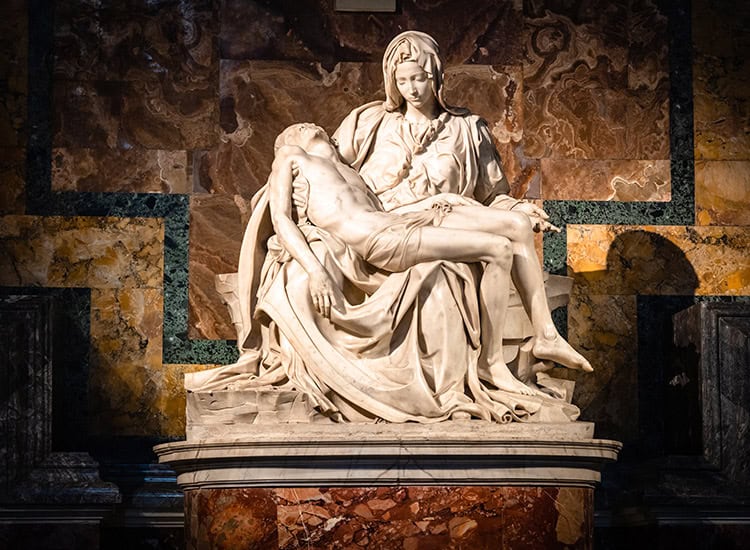
The marble Pieta statue was created for St. Petersburg Cathedral in Rome. Pieta is Michelangelo’s most “pathetic” work to date, and it is undoubtedly the beginning of his fame. At 23, Michelangelo accepted a commission from French Cardinal Jean de Lagraulas to make the Pieta statue in marble. A Roman gentleman named Jacopo Galli vouched for the project and was convinced that the Pieta would be “the most beautiful piece of marble ever produced in Rome.” Michelangelo spent two years in 1498-1499 completing this “majestic sculpture”. As a work of his youth, the “Pieta” statue already shows the greatness of his sculptures.
Due to the wide width of the Virgin’s garments, the entire structure of the Virgin and Jesus forms a very balanced pyramid shape. The dead Jesus lay relaxed in the arms of his mother. The Virgin was astonishingly young—too young to be his mother. The Virgin was depicted so young to highlight her holiness that was different from others. The Virgin is depicted so young to highlight the holiness that sets her apart from others. Michelangelo created a work of absolute perfection, in which the beauty of the body of Christ and the face of the Virgin reflects the light of divinity. However, the pain was obvious, and the Virgin was full of pain. She looked helpless and even tender toward her son lying in his arms. The “pieta” statue in St. Peter’s Basilica in Rome is the only work signed by Michelangelo.
Discobolus
Author: Myron
Author’s nationality: Greece
Creation time: 460 BC – 450 BC
Original size: 5.6 feet
Location: National Museum of Rome
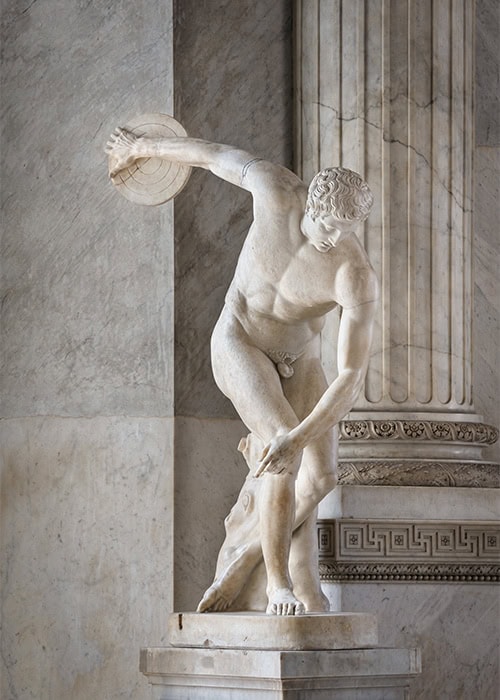
From Myron’s Discobolus, you can see that the sculptors of the time had liberated the human body from the early standing and frontal posture. The artist is obviously not only interested in shaping the athlete’s body, but also has a special liking for the movement of the Discobolus. Discobolus’ muscles are tense and ready to throw.
The work was still created from a frontal view, and it was not until the next actual artist began to conceive of the sculpture that it could be viewed from all angles.
It’s just a pity that the original Discobolus has been lost. In the 2nd century AD, the Roman emperor, who admired ancient Greek civilization, ordered people to recreate the Discobolus, and only then did three copies remain in the world. Now, they are stored in Naples, Rome, and London.
Venus de Milo
Author: Alexandros
Author’s nationality: Greece
Creation time: 150 BC
Original size: 6.7 feet
Location: Louvre Museum, France

The Venus de Milo or Aphrodite of Melos was found in a field along with other sculpture fragments, including a lone arm holding an apple. This arm should belong to Aphrodite. The apple may allude to the mythical “Judgement of Paris.”
After Venus de Milo was unearthed, it quickly attracted attention from all parties. Sadly, Greece was still under the rule of the Ottoman Turkish Empire. So, the mother country could not own this rare national treasure. To compete for the Venus de Milo, the Western powers used their strategies and launched a fierce competition. After a contest and even a battle, France became the final winner. They transported the statue to Paris and presented it to Louis XIV, King of France at the time (now in the Louvre Museum in Paris).
The Veiled Virgin
Author: Giovanni Strazza
Author’s nationality: Italy
Creation time: early 1850s
Original size: 19 inches
Location: St. John’s Cathedral

It depicts a bust of the Virgin Mary covered with a veil. Artists sculpted the hard marble into a veil resembling the real thing. Under the thin veil are her delicate facial features. The Virgin Mary has her eyes closed and her head bowed, appearing to be either praying quietly or expressing condolences, both of which are common in depictions of the Virgin Mary.
The Laocoon and His Sons
Author: Agesandros, Polydoros, Athanodoros
Author’s nationality: Greece
Creation time: 1st century BC
Original size: 6.7 feet
Location: Vatican Museums
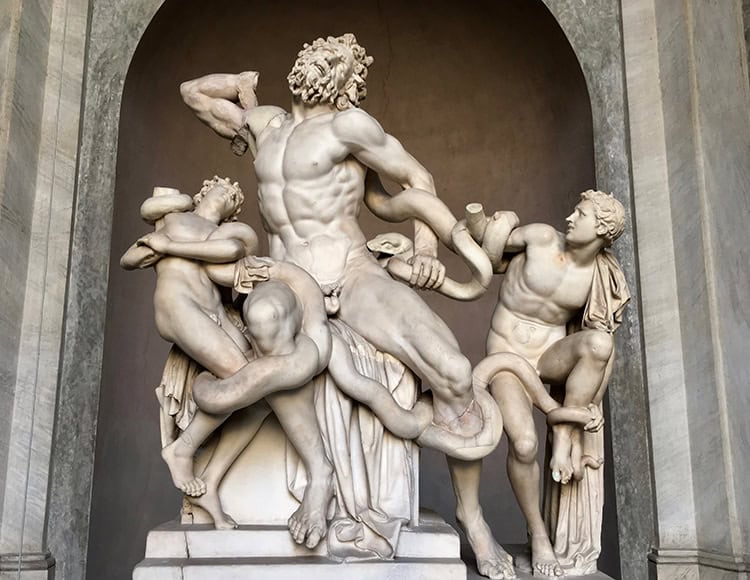
Laocoon was the priest of Troy. When the Achaeans surrounded the city of Troy and left the Trojan horse on the beach, Laocoon warned the Trojan leaders not to bring the horse into the city, fearing that it might be a trap. Athena pretended to be the helper and protector of the Greeks and punished Laocoon for his interference by subjecting him and his two sons to attacks by giant snakes.
The group statues of Laocoon and his sons may be copies of statues from the Greek period. Among the sculptures, a son breaks away from a poisonous snake and looks back at his father and brothers who are being killed. The Baroque style of the work links it to the Pergamon School. The same drama can be seen in the deformed muscles and painfully contorted expressions.
Farnese Heracles
Author: Lysippos
Author’s nationality: Greece
Creation time: 4th century BC
Original size: 10.2 feet
Location: National Archaeological Museum of Naples

The Hercules marble statue depicts Hercules holding the golden apple in his right hand after receiving the Apple of Hesperides. This sculpture is a Roman marble copy of an original Greek bronze statue, generally attributed to the 4th century BC sculptor Lysippos. The sculpture is supported almost entirely by Hercules’ right leg and a wooden stake covered with his signature lion skin, on which he reclines. Deliberate exaggeration of composition, or shifting of weight, is typical of 4th-century BC sculpture, but does not include heavy muscular forms.
The figure’s unusual weight may be due to its subject being the well-known Hercules, or it may be an exaggerated creation by Roman replicators to cater to the aesthetic requirements of Roman audiences. This statue was discovered in the ruins of the public baths of Carkara in Rome in the 16th century. Its strong realism inspired artists of the Italian Renaissance and later generations.
Wounded Amazon
Author: Lysippos
Author’s nationality: Greece
Creation time: 440-430 BC
Original size: 6.6 feet
Location: Museum of the Capital of Rome
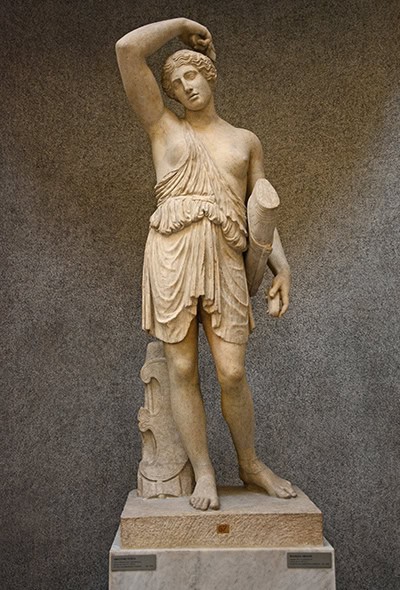
In Greek mythology, the Amazons were great warriors. In contrast to Greek society, women in Amazon society took on the role of hunting and fighting. In some myths, it is said that men are not allowed to enter their society, and some stories say that men are allowed to exist in their world, but they can only be responsible for household chores. In Greek art, the Amazons are mostly represented in battles with the Greeks. Given that female warriors represented a subversion of Greek social norms, it has been suggested that the Amazons may have been compared to the Greeks’ mortal enemies from the east, the Persians, and to “others” who were as unknown as the mysterious Amazons. ”, they were also the mysterious enemies of the Greeks.
Aphrodite of Knidos
Author: Praxiteles
Author Nationality: Athens
Creation time: 4th century BC
Original size: 6.7 feet
Location: Pio-Clementino Museum, Vatican (Italy)

Love Beauty Aphrodite, the goddess of sex, is famous for her beauty. The work depicts Aphrodite as the epitome of female beauty. Although a goddess, she is portrayed as a mortal through her fragility. Her nakedness and shy posture express fragility, and placing the statue in an outdoor shrine, where everyone can get closer and look closer, emphasizes its fragility and helplessness.
The naked Aphrodite became a common sculpture material in the park after the 4th century. It is also possible that Aphrodite provided the sculptor with the opportunity to display the female body in an erotic and carnal manner under the guise of a revered god.
Apoxyomenos
Author: Lysippos
Author’s nationality: Greece
Creation time: 330 BC
Original size: 6.9 feet
Location: Pio-Clementino Museum

In the 4th century BC, the idealized upright male figure was still a popular theme in sculpture. However, as the sculptor continued to experiment from multiple angles, the postures became more varied. Athletes who shave off sweat stains are examples of postural innovation. His right hand is forward, extending out of the plane where the body is located. Greek athletes will apply oil on their bodies before training. After the exercise, they return to the bathroom and scrape the oil away from their bodies. The hero of the sweat-stained athlete is scraping his body.
Apollo Belvedere
Author: Leochares
Author’s nationality: Greece
Creation time: 330-320 BC
Original size: 7.3 feet
Location: Vatican Museums
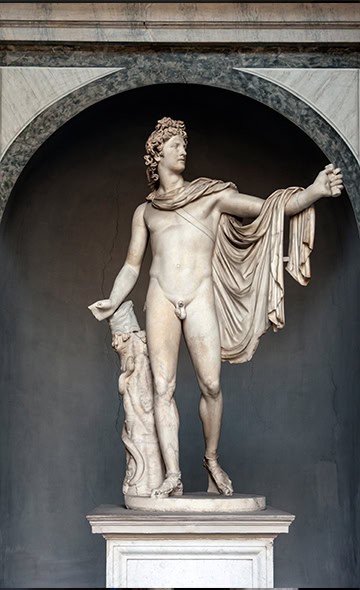
The marble statue of Belvedere Apollo is a copy of the world-famous Greek original that was discovered during the Renaissance in the 15th century and has been famous ever since. At that time, wealthy Italian nobles began to collect ancient sculptures found in the ruins of ancient Rome. The Apollo Belvedere became part of the Pope’s collection and is displayed in the courtyard of the Villa Observatory in the Vatican. There, countless visitors and artists were able to see the real face, and the artists also drew portrait sketches. Its replicas were ordered in large quantities and supplied to Europe. The proud and noble demeanor of the statue and the handsome face of Apollo deeply fascinated the European aristocracy of the 16th and 17th centuries as well as the Romantic artists of the 18th and 19th centuries.
Venus and Cupid
Author: Venus and Cupid
Author’s nationality: Greece
Creation time: late 4th century BC
Original size: 6.1 feet
Location: Louvre Museum
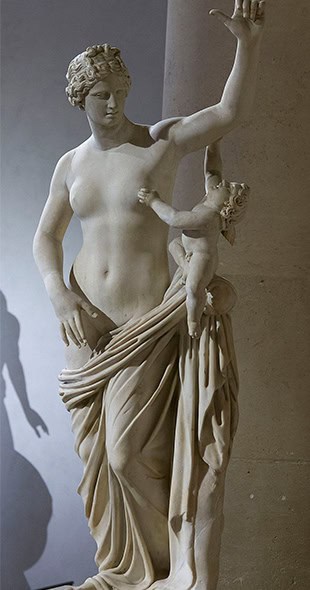
Due to her beauty, which provided an acceptable excuse for the erotic representation of the female body, Aphrodite became a common subject for Greek sculptors after the 4th century B.C. She sometimes appeared with her son Iros, as shown in the work, known to the Romans as “Cupid” and later as “the cherub”. He is a little angel with wings, symbolizing the love between the human world and the divine world. In Roman art and mythology, Aphrodite accordingly became Venus, the goddess of love. In the eyes of the Romans, Aphrodite had a lofty status and was regarded as the ancestor of Caesar, Augustus, Julio Claudian, etc., and even extended to the symbol of the Roman people. This humorous depiction of Aphrodite and Iros or Venus and Cupid hints at the Greek view of Aphrodite and Iros, namely that she was seen not only as a symbol of sensual beauty but occasionally also funny.
Diana of Versailles
Author: Praxiteles
Author’s nationality: Greece
Creation time: 330 BC
Original size: 6.6 feet
Location: Louvre Museum
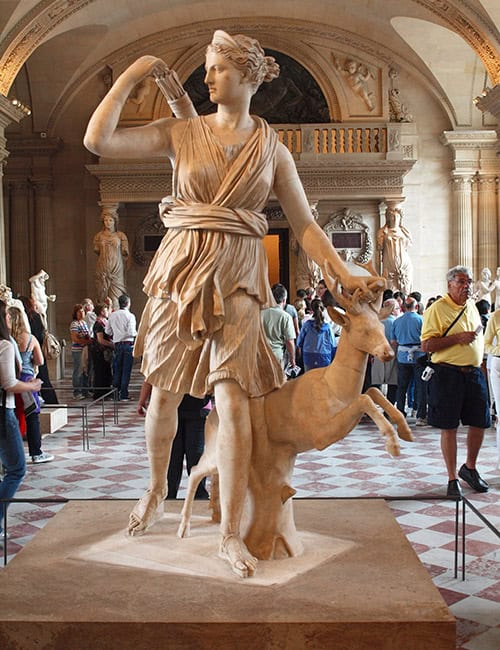
This marble statue depicts Artemis as a strong, striding hunter with a deer at her side. Artemis is a virgin goddess, a huntress, and the protector of the wilderness and fertility. She and Apollo are twins. This replica of the statue is often compared to Apollo Belvedere, and her dual role as a hunter and livestock defender can be seen in the work. She is hunting, accompanied by a deer, who is also under her protection. She reached for the arrow with her other hand, which was later restored. She strides powerfully and her clothes swing when she walks, which is a typical new body posture after the 4th century BC.
Barberini Faun
Author: Vincenzo Pacetti
Author’s nationality: Italy
Creation time: late third century BC or early second century BC
Original size: 7 feet
Location: Glyptothek
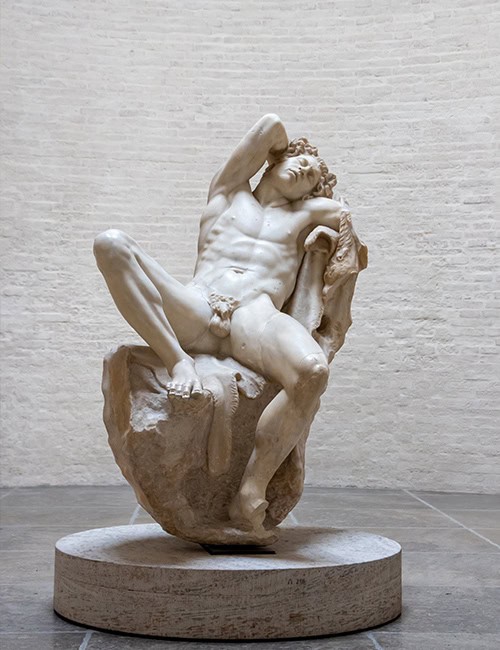
In the Hellenistic period, wealth meant being able to afford sculptures, and people placed them in private rooms and gardens. Since then, more and more pornographic themes have emerged. This marble sculpture depicts a sleeping faun, perhaps drunk, lazily stretching himself on an animal skin. The undisguised nakedness of the body in this pose no longer suggests that he is a hero, athlete or god, but rather demonstrates his sexual prowess. The naturalistic and idealistic description of the faun’s body is a legacy of the High Classic.
Winged Victory
Author: unknown
Author nationality: unknown
Creation time: unknown
Original size: 9 feet
Location: Louvre Museum
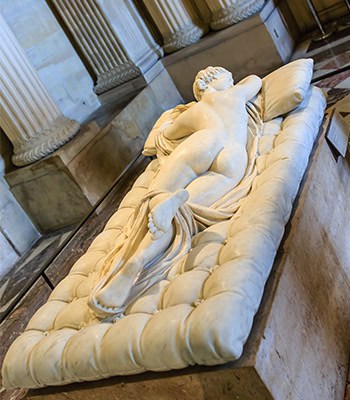
At the end of the 4th century BC, after Alexander the Great conquered Greece, the Near East, and Egypt, Greek art entered a new global era. At this time, the wealth and exotic tastes of foreign kings brought different styles into Greek sculpture and architecture. The most powerful example of Hellenistic art at this time is the Victory of Samothrace, which was part of a large temple complex on the island of Samothrace in the North Aegean Sea. The original goddess of victory was on the battleship’s bow, symbolizing victory. The prow is carved from stone and serves as the base for this passionate piece.
The entire work was originally placed in a landscape with fountains, suggesting the sea waves. This approach to landscape, art, and drama is typical of Hellenism. The figure is reminiscent of the goddess of victory from the 5th century BC, with her robes pleated and elegantly wrapped around her body. But in this work, the viewer can almost feel the wind whipping her clothes from all directions. The clothes flow around her thighs in two directions simultaneously, giving the work a sense of power that has never been seen in previous sculptures.
Sleeping Hermaphroditus
Author: Unknown, Gian Lorenzo Bernini (mattress)
Author’s nationality: Unkown, Italy
Creation time: 155 BC
Original size: 67 inches
Location: Louvre Museum

A young naked girl is resting on the bed. When we look at it from different angles, she seems to be somewhat masculine. In fact, what you see is a hermaphrodite. He was the son of Hermes and Aphrodite. Once after he rejected a nymph, the goddess asked Zeus to turn him into a hermaphrodite. The theme of gender ambiguity became popular in the late Hellenistic period because it surprised the viewer. This Roman copy of a 2nd century BC Greek statue fascinated collectors, one of whom ordered Bernini to carve the mattress beneath Hermaphroditus.
Farnese Bull
Author: Tauriskos of Tralles, Apollonius of Tralles
Author’s Nationality: Ancient Greece
Creation time: late 2nd century BC
Original size: 7.8 feet
Location: National Archaeological Museum, Naples
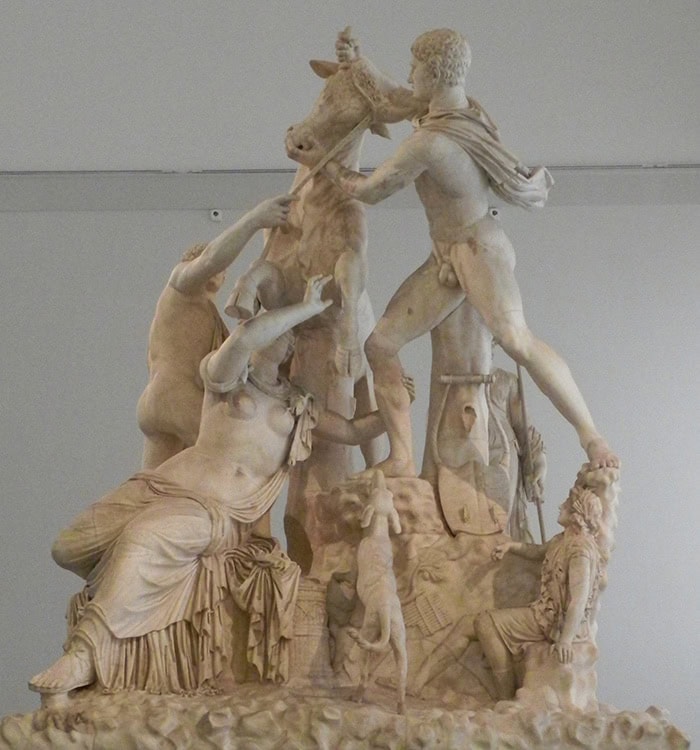
The Farnese Bull marble sculpture is one of the largest sculptures of antiquity and was created during the Hellenistic period in the 2nd century BC. It has all the hallmarks of Hellenistic sculpture: an exquisite composition of multiple figures, dramatic movements and pyramidal shapes.
This copy decorated the Baths of Caracalla in the late Roman Empire. It was rediscovered here in the 16th century and placed in the Palazzo Farnese, the residence of the Pope. The sculpture is based on the story of Antiope and Dierke. Antiope, the mother of twin brothers, was forced to abandon her children. The twins survived, but her punishment was to become a slave to her uncle’s wife Dirk. Antiope escaped and went to look for her sons, but Dierke found her anyway and ordered her to be tied to a bull and trampled on her. The sons rescued Antiope and, in turn, punished Dirk. The statue shows the boys tying Dirk to a bull, and Dirk’s fate is self-evident.
The Three Graces
Author: Antonio Canova
Author’s nationality: Italy
Creation time: 1841-1847
Original size: 3.9 feet
Location: Hermitage Museum
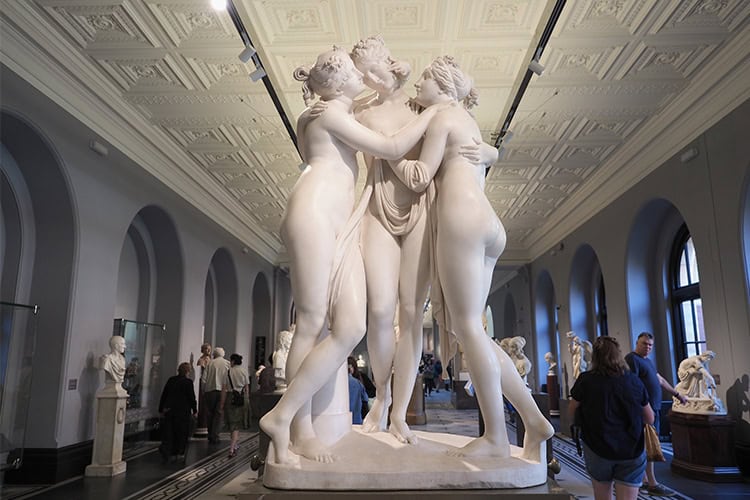
The Three Graces are Beauty, Gentleness, and Joy. They monitor celebratory events such as balls and banquets. They are Aphrodite’s companions, providing the happiness that comes with love. Like Aphrodite, they are often depicted naked and dancing in a circle. In each goddess, the familiar principle of centric balance, or symmetry of the figure’s posture, developed in the 5th century BC. However, the work’s composition is much more exquisite than any work of the High Classic period. It was not until the Hellenistic period that complex multi-figure group sculptures appeared in independent postures without relying on support. The figures were connected through embraces and became a whole. They face different directions, making it enjoyable to watch from any angle.
Augustus Prima Porta
Author: unknown
Author’s nationality: unknown
Creation time: 50 BC
Original size: 6 feet 10 inches
Location: Vatican Museums

Augustus was Rome’s first emperor, and he changed the way Romans created art and iconography. He abandoned the realist style of Roman iconography and preferred to imitate the style of the High Classical Period of the 5th century BC.
This portrait was found in the front villa of Augustus’s wife, Livia. In the work, Augustus’ posture is modeled after Polycletus’s “Spear Bearer.” Augustus was a strong advocate of everything associated with the High Classic, including empire, rights, and democracy. He sought to appease those who resented his dictatorship and his actions in ending the Roman Republic. He told people he was a fair and democratic leader who could represent the Senate and the Roman people.
Dying Gaul
Author: unknown
Author’s nationality: unknown
Creation time: unknown
Original size: 36.6 inches
Location: Capitoline Museums

The great marble sculpture shows the scene of the failure of the Gauls: a wounded Gallic warrior sitting on the ground, his head lowered, his expression showing the pain caused by the injury and unyielding perseverance. His body tilted forward to the right, with his right hand supporting the ground and his left knee bent as if he was still trying to stand up.
Although the original intention of the statue was to show off Pergamon’s military exploits, the image of the Gallic warrior in the work was expressed as a hero unwilling to surrender, and people seemed to be able to see the blood flowing from his body. The statue profoundly reveals the complex emotions of a hero in a critical moment, showing the bravery, competitiveness and indomitable spirit of the Gauls. In this work, the Greek sculptor used reverse psychology to depict the bravery and tenacity of the enemy, probably to illustrate how difficult it is to defeat such an enemy, thereby promoting the ruler’s military exploits.
Borghese Gladiator
Author: Agasias
Author nationality: Ephesus
Creation time: 100 BC
Original size: 78.3 inches
Location: Louvre
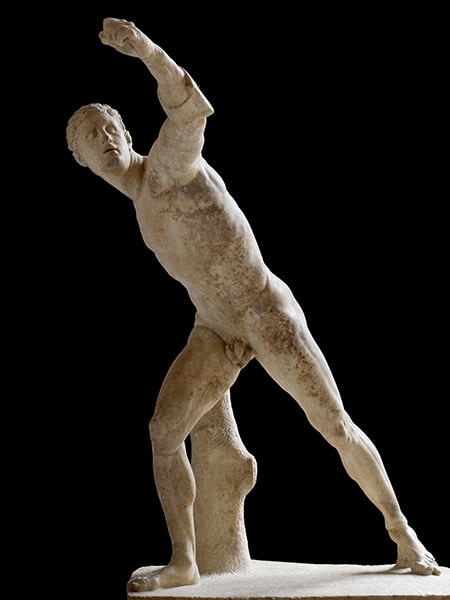
This Roman copy of a Greek original dates to the 4th century BC. It was discovered in the early 17th century and later came into the possession of Bishop Borghese. It has long been thought to depict a gladiator, but recent information suggests that the work is likely to depict an athlete or warrior. Much discussion has been about the work’s idealization of the muscles and the subject’s anatomy. The artist was seeking to reproduce as realistically as possible the size, posture, and power of this forward-bodied figure.
Bacchus
Author: Michelangelo
Author’s nationality: Italy
Creation time: 1475-1564
Original size: 6.66 feet
Location: Bargello Museum
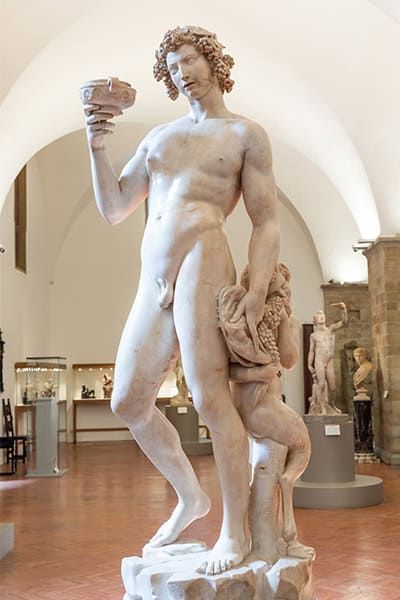
Bacchus is the god of wine and plants in Roman mythology, corresponding to Dionysus in Greek mythology. Regarding the birth of Bacchus, a scene similar to that of Dionysus is recorded on an ancient relief in the Vatican Museums. After taking out Bacchus from the belly of the goddess Simle, the god Jupiter held the child in his lap for three months. From the relief, you can see that Bacchus was coming out of the lap of the father God after he was full term. At this time, Hermes, the god of animal husbandry, was standing aside, holding clothes in his hands, preparing to deliver the baby god. At the same time, the three Parques (Parques), who controlled life, death, and destiny, wanted to pray for the newborn baby god.
Abduction of a Sabine Woman
Author: Giovanni Bologna
Author’s nationality: Italy
Creation time: 1529-1608
Original size: 13.45 feet
Locatin: Piazza della Mujeres, Florence

The Rape of the Sabine Women by Giambologna is a classic work that reflects the artist’s superb skills. The title of the work is an obvious allusion to a mythological story, and one can see the work as an allegory of three stages of life: frail youth, adulthood at the peak of physical prowess, and old age. This group of sculptures was carved from an abandoned piece of marble. Among the three figures maintaining balance, it shows that the artist is quite skilled in the use of techniques.
The Rape of the Sabine marble statues makes full use of the method of spiral shaping of figures. The complex interweaving of the marble sculptures and the carving techniques of the human body make this work one of the most beautiful Mannerist sculptures and pushed Giambologna to the pinnacle of his art. His discovery of beauty seems to have been at the peak of aesthetics. For more than three centuries, Giambologna’s sculptures have been loved by everyone, but Michelangelo is an exception. Michelangelo is the role model for Giambologna. Giambologna’s research on sports and lifting movements influenced many of his successors, such as Bernini. The history of sculpture regards Giambologna as an obvious and necessary connection between Michelangelo and Bernini. Giambologna’s style influenced the entire Baroque movement.
The Rape of Proserpina
Author: Gian Lorenzo Bernini
Author’s nationality: Italy
Creation time: 1621-1622
Original size: 7.38 feet
Location: Borghese Gallery
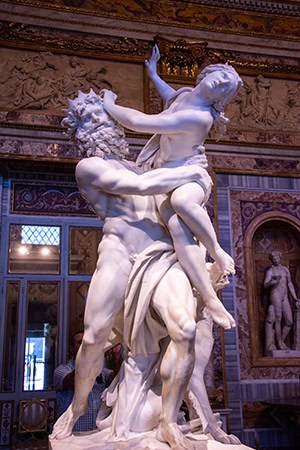
The theme of “The Rape of Proserpina” sculpture is taken from Greek mythology, showing the story of Proserpina, the daughter of Ceres, the goddess of cereals and farming, who was kidnapped by her uncle Pluto, the main god of the underworld. He wants to marry her.
The sculpture is carved from Carrara marble. The drapery folds throughout the work further enhance the dynamics of the spiral. The posture of this group of statues is very unique. The goddess is trying her best to escape from the captors. The lines of her hands are elongated, and the entire sculpture looks like it is soaring into the sky. This sculpture is in typical French sculptural style.
David (Bernini)
Author: Gian Lorenzo Bernini
Author’s nationality: Italy
Creation time: 1623-1624
Original size: 67 inches
Location: Borghese Gallery
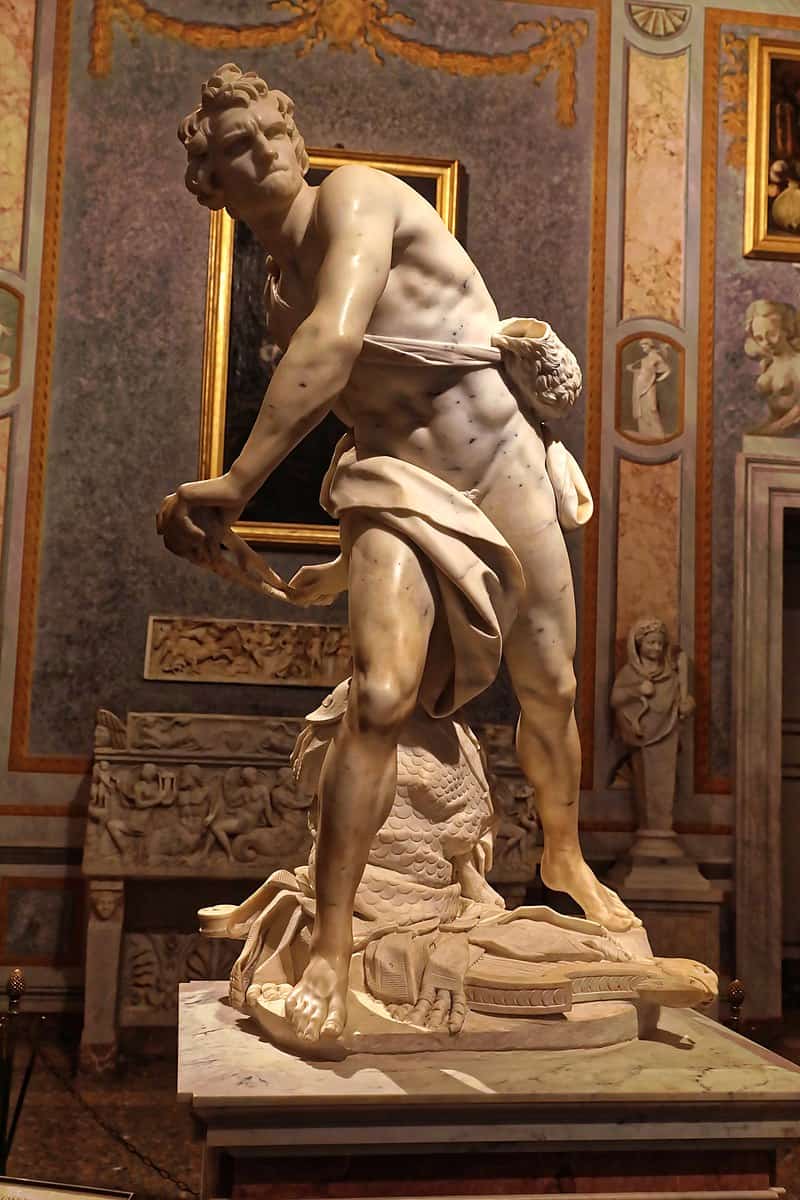
If previous sculptors depicted the religious hero before or after his victory over the giant Goliath, Bernini chose to show the battle process and express the dynamic. All of his works continually pursue and surpass this dynamic expression.
Michelangelo successfully expressed his awe for the harmony and ingenuity of nature, while Bernini emphasized the dramatic tension of biblical stories. Bernini concentrated on depicting human expressions in his life-size works. David’s face is tense with concentration, showing his confidence. Likewise, this tension is also reflected in the character’s limbs and back. Deep in the marble skin, the muscles are trembling, showing full tension. This work was created at the request of the Borghese family and was inspired by the ancient marble sculpture “Borghese Gladiator.” This sculpture is now in the Louvre. The young artist set an example of dynamic expression (such as the distance between his feet) in this work, and from this work we can also see his talent in future works.
Apollo and Daphne(Bernini)
Author: Gian Lorenzo Bernini
Author’s nationality: Italy
Creation time: 1622-1625
Original size: 96 inches
Location: Borghese Gallery

The statues of Apollo and Daphne are dazzling symbols of the Roman Baroque trend. They perfectly interpret the theme of the majestic movement and express the emotions of this great artist, Bernini.
The sculpture is based on curves and successfully captures the moment when the fairy changes. Her body is light and ready to fly. , when Daphne had to face her fate, her face was full of panic, showing endless sadness, and she ran away in panic. Apollo is depicted as a vigorous young man who approaches the young woman firmly and confidently, unwilling to let her escape. This group of statues is carved from a piece of white Carrara marble, with pure lines and fascinating skillful techniques. Bernini is good at using this magnificent material to express all human emotions.
Milo of Croton
Author: Pierre Puget
Author’s nationality: France
Creation time: 1620-1694
Original size: 106 inches
Location: Louvre Museum

Milon of Croton is a representative work of the French Baroque style. The entire court was shocked when the sculpture was sent to Versailles in 1683. Pierre’s education in Baroque art in Rome, and the sculpture he presented to the king, truly set him apart from other sculptors.
In the ancient Olympics, Milo won many competitions. Once while walking in the forest, to test his strength, he tried to tear apart a tree stump. Just when he was about to succeed, his hand was caught by a tree stump. He was exhausted and was eventually eaten by a wolf. Even though Puget replaced the wolf with a lion, there is still a power that is slowly being depleted by time in the work he presented to the king.
Carved from a single block of Carrara marble, the sculpture’s astonishing power and tension rely solely on contrasting lines. The sculptor’s virtuosity is evident not only in the portrayal of Mirren’s pain but also in his expertise in carving the base. This enhances the tension of the lines and the intense emotion expressed in this monumental work.
Psyche Revived by Cupid’s Kiss
Author: Antonio Canova
Author’s nationality: Italy
Creation time: 1787-1793
Original size: 61 inches * 66 inches
Location: Louvre Museum
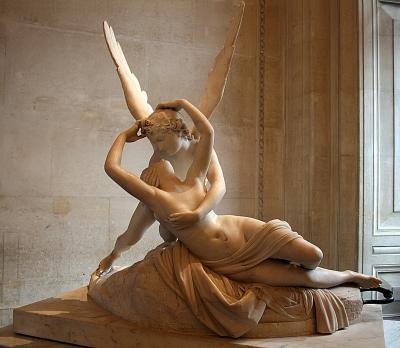
This marble sculpture describes the myth of Psyche (the beauty incarnated by the soul in Greek and Roman mythology). Because of her beauty, Psyche aroused Venus’s jealousy. This mortal woman fell into a deep sleep under Venus’s magic. Only love could awaken her. The artist represents the climax of the story: Jupiter, the god of love, awakens his lover, marries her, and elevates her to a goddess.
This masterpiece with the theme of love shows its essence: not only the purity and simplicity of the outline, the graceful elegance of the shape, but also the harmonious composition, the pyramid-shaped composition makes the marble work look as light as an angel.
Pauline Bonaparte as Venus Victrix
Author: Antonio Canova
Author’s nationality: Italy
Creation time: 1757-1822
Original size: 61 inches * 66 inches
Location: Borghese Gallery

The statue of Pauline Bonaparte was commissioned by her husband Camillo Borghese, who wished to immortalize his wife’s beauty in the guise of Venus, and the apple held by Pauline in the statue is reminiscent of the Judgment of Paris. According to Canova’s compositional form, he drew inspiration from the “Venus” of the ancient sculptor Praxiteles. The young woman was reclining on a chaise longue, with only a thin sheet covering her legs. This gesture, combined with the exquisite carving, shows Paolina’s nobility and beauty. To accentuate the marble’s luster, Canova coated it with a thin layer of pale pink wax.
Il Disinganno
Author: Francesco Queirolo
Author’s nationality: Italy
Creation time: 1753
location: Cappella Sansevero
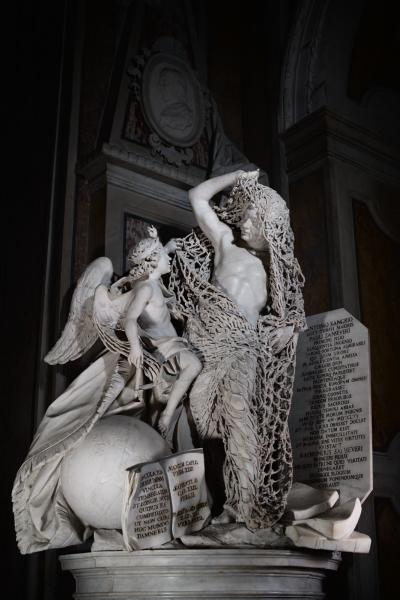
The Release from Deception is described in the book Istoria dello Studio di Napoli as “The last and hardest test a sculpture can pursue”.
YES, this is not an exaggerated description. Everyone who has seen it is amazed by its superb sculpture art, and even cannot help but touch it with their hands to confirm whether the fishing net on the statue is a prop or marble carving. It is hard to imagine how much effort Francesco Queirolo put into this sculpture. Without the help of modern tools, the author needed to turn the sharp chisels and files in his hands into like brushes to paint carefully. Because carving an entire fishing net on marble is like walking a tightrope on a cliff. Any mistake represents an irreparable price.
An angel with a blazing flame on his head has his feet on the earth, and a Bible is placed next to the earth. He gently rescued a bearded man from the fishing net that represented sin. The implication here is that worldly happiness is only short-term deception, and faith and wisdom can save people from worldly deception.


Pingback: enclomiphene american express canada
Pingback: kamagra livraison rapide
Pingback: discount androxal price for prescription
Pingback: ordering flexeril cyclobenzaprine australia buy online
Pingback: how to buy dutasteride cheap discount
Pingback: discount gabapentin purchase online safely
Pingback: how to buy fildena generic equivalent
Pingback: cheap itraconazole generic from canada
Pingback: online order staxyn buy germany
Pingback: cheap avodart us overnight delivery
Pingback: buying xifaxan price uk
Pingback: No r x needed for purchasing rifaximin
Pingback: levné bez předpisu kamagra